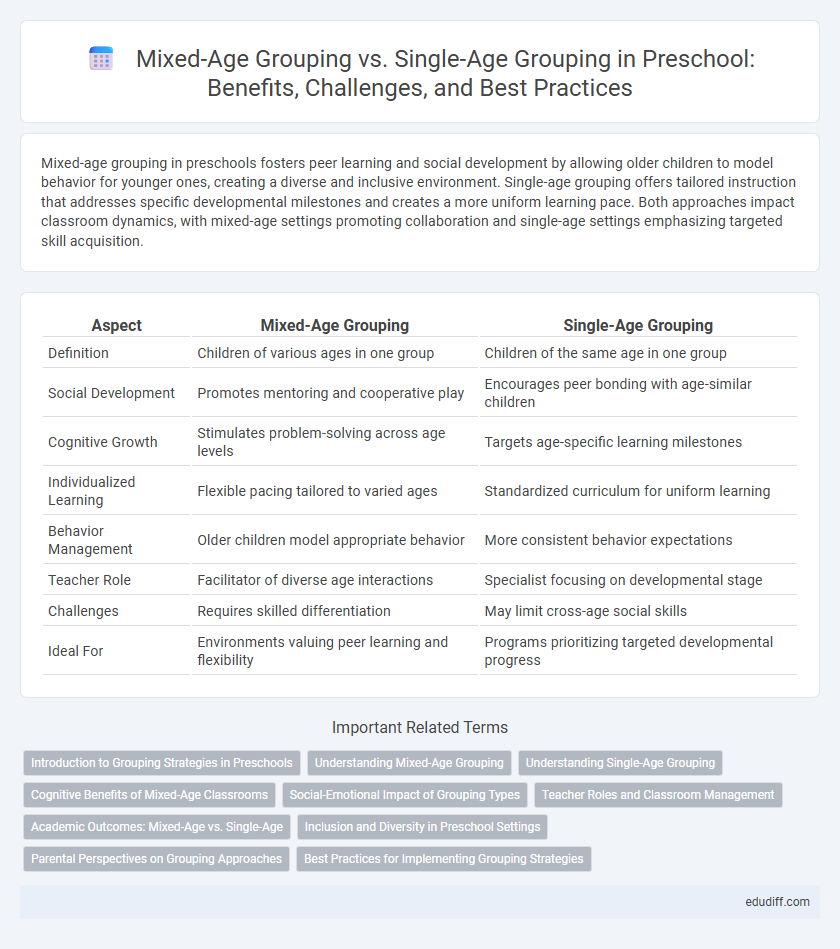Mixed-age grouping in preschools fosters peer learning and social development by allowing older children to model behavior for younger ones, creating a diverse and inclusive environment. Single-age grouping offers tailored instruction that addresses specific developmental milestones and creates a more uniform learning pace. Both approaches impact classroom dynamics, with mixed-age settings promoting collaboration and single-age settings emphasizing targeted skill acquisition.
Table of Comparison
| Aspect | Mixed-Age Grouping | Single-Age Grouping |
|---|---|---|
| Definition | Children of various ages in one group | Children of the same age in one group |
| Social Development | Promotes mentoring and cooperative play | Encourages peer bonding with age-similar children |
| Cognitive Growth | Stimulates problem-solving across age levels | Targets age-specific learning milestones |
| Individualized Learning | Flexible pacing tailored to varied ages | Standardized curriculum for uniform learning |
| Behavior Management | Older children model appropriate behavior | More consistent behavior expectations |
| Teacher Role | Facilitator of diverse age interactions | Specialist focusing on developmental stage |
| Challenges | Requires skilled differentiation | May limit cross-age social skills |
| Ideal For | Environments valuing peer learning and flexibility | Programs prioritizing targeted developmental progress |
Introduction to Grouping Strategies in Preschools
Preschool grouping strategies impact social development and learning dynamics, with mixed-age grouping fostering peer mentoring and diverse interaction opportunities. Single-age grouping promotes age-specific curriculum alignment and targeted developmental support. Educators choose based on goals like individualized instruction versus collaborative social skills growth.
Understanding Mixed-Age Grouping
Mixed-age grouping in preschool settings fosters peer learning by enabling younger children to develop social and cognitive skills through interactions with older peers while older children reinforce their knowledge by mentoring. This approach encourages a diverse range of developmental stages within a single classroom, promoting adaptability and collaborative problem-solving. Research shows that mixed-age groups enhance emotional intelligence and resilience compared to single-age grouping, which often limits social exposure and learning opportunities.
Understanding Single-Age Grouping
Single-age grouping in preschool organizes children of the same developmental stage, allowing tailored instruction that targets specific cognitive and social milestones. This method supports focused curriculum planning and eases classroom management by aligning activities with uniform learning needs. Research indicates single-age classrooms can enhance skill mastery and provide predictable environments conducive to early childhood development.
Cognitive Benefits of Mixed-Age Classrooms
Mixed-age classrooms foster cognitive development by encouraging peer learning, where older children enhance their critical thinking by teaching younger peers. This dynamic promotes problem-solving skills and adaptability, as children encounter diverse perspectives and developmental stages. Research indicates that mixed-age settings improve executive functioning and social cognition more effectively than single-age groups.
Social-Emotional Impact of Grouping Types
Mixed-age grouping in preschools fosters empathy, cooperation, and leadership skills as older children model positive social behaviors for younger peers, enhancing emotional regulation and confidence. Single-age grouping provides age-specific social interactions that help children navigate developmental challenges with peers experiencing similar growth stages, promoting focused emotional understanding. Both approaches influence social-emotional development, but mixed-age settings often encourage more diverse social problem-solving and adaptive skills.
Teacher Roles and Classroom Management
In preschool settings, mixed-age grouping requires teachers to adopt flexible roles, guiding diverse developmental stages while fostering peer learning and collaboration. Classroom management in mixed-age groups emphasizes individualized attention and adaptive strategies to meet varied social and cognitive needs. Single-age grouping allows teachers to target specific age-appropriate curricula and maintain consistent behavior expectations, streamlining classroom routines and instructional methods.
Academic Outcomes: Mixed-Age vs. Single-Age
Mixed-age grouping in preschools promotes collaborative learning, enhancing cognitive flexibility and social-emotional skills compared to single-age classrooms. Research indicates children in mixed-age settings often demonstrate higher problem-solving abilities and adaptability, benefiting from peer modeling and diverse interactions. In contrast, single-age grouping allows for targeted curriculum pacing but may limit exposure to varied perspectives crucial for early academic development.
Inclusion and Diversity in Preschool Settings
Mixed-age grouping in preschool settings enhances inclusion and diversity by allowing children of different developmental stages to learn from one another, fostering empathy and social skills. Single-age grouping may limit exposure to diverse perspectives and interactions, potentially restricting children's understanding of varied abilities and backgrounds. By embracing mixed-age classrooms, preschools create a more inclusive environment that supports individualized learning and reflects real-world social diversity.
Parental Perspectives on Grouping Approaches
Parents often express a preference for mixed-age grouping in preschools due to its potential to foster social development, empathy, and peer learning among children of different ages. Some parents value single-age grouping for its targeted curriculum tailored to specific developmental stages, believing it supports focused skill acquisition and age-appropriate interactions. Surveys reveal that parental perspectives on grouping approaches vary significantly based on their educational priorities and beliefs about socialization and academic readiness.
Best Practices for Implementing Grouping Strategies
Implement mixed-age grouping in preschool settings by fostering peer learning and social development through carefully planned activities that accommodate varying skill levels. Single-age grouping benefits from tailored curriculum and targeted developmental goals, ensuring age-appropriate challenges and consistent progression. Best practices include ongoing assessment and flexible grouping adjustments based on children's individual needs, promoting inclusive and effective learning environments.
Mixed-age grouping vs Single-age grouping Infographic

 edudiff.com
edudiff.com